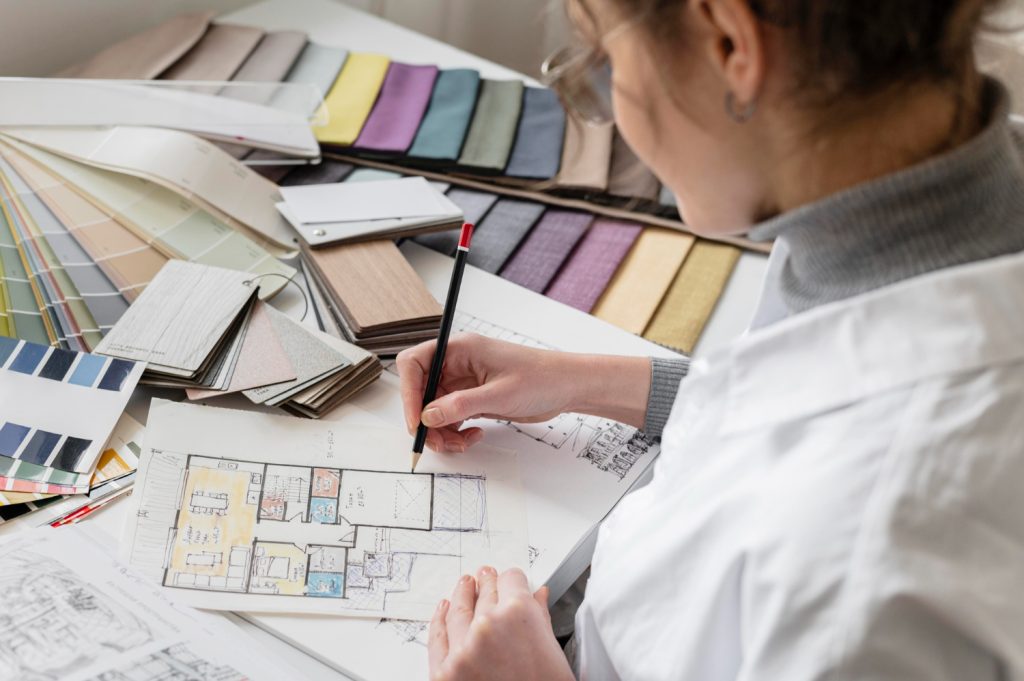Interior Design Courses: Your Gateway to a Thriving Career in Decorating
What is the first thing you notice when you are, say, at a cafe or any space for that matter? Do you try to associate your state of mind during the time with the space you are in? Do different colors patterns, and atmospheres make you feel differently? Welcome to the world of interior design. Something about interior design that we must understand is that it goes beyond just aesthetic requirements. It is deeply scientific and also caters to human psychology and behaviors. If you find yourself to be someone passionate about transforming spaces and have an eye for detail – The Interior Design industry is where you need to be. In this blog, we will take a look at how you can navigate your interior design career with the right course and how to grow in the industry.
What is the Role of an Interior Designer?
Putting two and two together, as the term suggests, an Interior Designer is a professional who designs interiors; which is the basics. However, the significance of an interior designer transcends beyond just designing and is not limited to that. It is about transforming and maybe even redesigning a space into an experience. There is no ‘one approach that fits all’ concept here, because designing a space is subjective and very personal as preferences and visions vary from person to person.
An Interiors designer is required to take critical and creative decisions, come up with plans that best works for the clients with all their requirements in mind, must have spatial awareness, must know the importance of integrating colour theory and colour psychology, furniture placements, must also make sure that all of this fits within the discussed budget and understanding that beyond aesthetics, a place must also be functional and accessible.
Why Should you go for an Interior Design Course?
The world of interior design is dynamic and multidisciplinary. You get to learn from and explore various avenues. The course and the industry come with various perks and benefits. Some of them are:
- Gaining Foundational Knowledge
Do you want free career counseling?
Ignite Your Ambitions- Seize the Opportunity for a Free Career Counseling Session.
- 30+ Years in Education
- 250+ Faculties
- 30K+ Alumni Network
- 10th in World Ranking
- 1000+ Celebrity
- 120+ Countries Students Enrolled
During the course of your interior design class, you get to learn the fundamentals and basics of color theory, principles of design, space planning, and major architectural concepts.
- Being Able to Make a Difference
As aforementioned, creating and transforming spaces for your clients is a personal experience as you get to make people’s dreams a reality. Creating a functional and comfortable space can help make people happy and cater to their emotional well-being. People tend to function well while in spaces that make them feel connected, productive, and at peace.
- Prospects for Career Growth
The interior design industry offers opportunities for lucrative career options and the space to grow. Typically the interior design industry offers competitive salaries than most professional fields of work.
Book Now →
- Networking Opportunities
Your interior design course and the industry in general offers the opportunity to associate, communicate, and collaborate with like-minded peers and industry specialists. This could be a suitable occasion for community building, learning new insights, and keeping up with industry trends.
- Developing a Strong Portfolio
The interior design course you have enrolled in offers various workshops, internships, and/or apprenticeship platforms where you get to explore what it is like to practically apply everything you learned and get hands-on experience while working in the field and other work sites.

How to Choose the Right Interior Design Course?
Research is an important aspect before choosing a course and college for your educational journey. Here are a few key points to consider before making a decision:
Do you want free career counseling?
Ignite Your Ambitions- Seize the Opportunity for a Free Career Counseling Session.- Accreditation
Ensure that the course and college you go for are well accredited and recognized by prominent bodies and organizations. This ensures that the institution is acclaimed and provides quality education.
- Faculty
All college websites have details of who their faculty is. An exceptional panel of faculties will ensure that you will receive the best of your education. Industry experts with relevant experience can guide you through your journey.
- Curriculum
While doing your research, make a list of colleges you would like to study in and take a look at the curriculum details provided on their website. Make specific note of internships and apprenticeship opportunities they offer.
- Duration and Cost
Make sure that the duration of the course and the cost you will have to incur aligns with your goals and requirements. Also, look out for scholarship and educational – aid options provided by the college and other facilities.
- Placement Records
All colleges provide details of the companies and firms they are associated with to provide employment and placement opportunities for their students. Look out for reputed firms and companies collaborating with the college that you want to enroll at
- Specializations
Most courses have specialization options. If you are looking at joining institutes and colleges for your interior design journey, make sure to look out for courses that offer specializations and the scope to branch out within the industry.
How to Get Started with Interior Design?
- Do your research and readings.
- Note down the criteria for admissions.
- Eligibility for various courses are as follows:
- Diploma courses: 10th Grade
- Bachelor in Interior Design: 12th Grade
- Masters in Interior Design: Must have completed Bachelors
- Doctorate: Masters in Interior Design
- Average salary after completing all education requirements: 1.2 Lakh per annum to 6.6 Lakhs per annum.
- Interior Design job profiles: Interior designer, Researcher, Interior Design Instructor or Teacher, Design Consultant, Design Journalist, Product Designer.
- Entrance exams to look out for are NIFT, NID, Pearl Academy Entrance Exam, CEED, IIAD Entrance Exam, and WUD Entrance Exam.

Conclusion
The interior design industry is for all creative and artistic souls and as time goes by, the industry keeps growing. You get to see your career trajectory grow with the multifold opportunities the industry has to offer. The right course, the right college, and the right guidance will ensure you a lucrative experience as an interior designer. You gain the knowledge, experience, confidence, and skills to transform spaces into what people look forward to. The very fundamental of interior designing, beyond theories and technical knowledge, is to understand that spaces are, first, all about how it makes one feel and, second, how it appeals. If you’ve read till here, you are already on the right path and we are sure you’ll do great.

AAFT has been providing the world with limitless creativity and expression since 1993! Through a dynamic and industry-driven curriculum, AAFT provides engaging and captivating articles to persuasive blogs and empowers its readers to explore diverse avenues of creative media education-related content.










